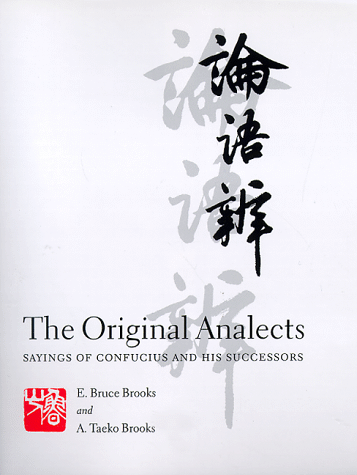Books
The Original Analects
E Bruce and A Taeko Brooks
Columbia 1998
This was the first detailed presentation of a portion of Bruce and Taeko's larger theory of the dates and interrelations of the Warring States texts, and concerns the Analects (Chinese, Lun Yw), to this day a central document of the Chines philosophical heritage and national consciousness. It follows a line of investigations pursued by previous scholars over more than a thousand years: Lyou Dzung-ywaen (Chinese, Tang Dynasty), Hu Yin (Chinese, Sung Dynasty), Itô Jinsai (Japanese, 1627-1705), Tswei Shu (Chinese, 1760-1815, to whom the book is dedicated), Arthur Waley (British, 1889-1966), and Timoteus Pokora (Czech, 1928-1985). Each of these distinguished early and late chapters; Pokora showed that all their findings mutually compatible, making the text an accretion product, and not simply a jumble. Bruce and Taeko's work takes the final step, recognizing each chapter as a separate accretion layer, and assigning to each its probable author (first, a series of disciples; then, a succession of members of the Kung family) and its approximate date. The resulting time depth is 230 years, from the death of the Historical Confucius in 0479 to the destruction of Confucius's state of Lu in 0249. It reveals the Analects, not as a collection of Confucius sayings, but as a growing repository of such sayings, all but the first few being inventions of successive Confucian School heads, to keep "Confucius" current with contemporary needs and issues.
Several Appendices provide detail about Confucius and his disciples. The last shows how effective was the device of preposing certain key chapters. The chief issue seems to be political: first 3, a political response to the Chi usurpation of the Kingship in 0342; then the first turning away from war and toward a more familial self-concept in 2, and in 1, the final departure of the Confucians from court over their antiwar stance, and their argument that private virtue is also a valid form of state service.
The full text of The Original Analects is available elsewhere on this site. Here, by way of first acquaintance, are some key chapters and Appendices, with probable author and date:
LY 4 (the core of remembered sayings). Dz-gung, c0479
LY 7 (a reconfigured and slightly Indianate "Confucius"). Dzvngdz, c0440
LY 9 (a further developed "Confucius," with clear Buddhist influence). Dzvng Ywaen, c0405
LY 12 (the impact of definition; de-emphasizing meditation). Dz-jing and Mencius, c0326
LY 1 (the Confucians out of power). Dz-gau, c0294
LY 18 (includes a spirited response to the Jwangdz). Dz-shvn, c0262
Appendix 3 (the interweaving of Confucian and other strands of thought)
Appendix 4 (Confucius and his circle)The authors confess a certain pride in p268 note 32, where the question of the historicity of an exploit attributed to Confucius' father is carried to lengths undreamed of in previous scholarship, thus validating at least this part of the legendary tradition, and helping to clarify Confucius's personal background and social position.
What, in the end, is the importance of the Analects? Confucius himself is long gone, but what he achieved in his time was tremendous: the adaptation of the socially and militarily obsolete ethic of the Spring and Autumn chariot warrior to the needs of the new age, the age of the bureaucratic state and total war. Remarkable is the international character of this reformulated ethos, an implicit recognition that dedication to the public interest transcends national boundaries. The West has its tradition of service to others, but it is a weak tradition; the dominant philosophy stresses "eudaimonia," personal well-being. The most important contribution of the Confucius of the Analects may be to provide a stronger foundation, a wider heritage, for that complementary tradition. And in the process, readers can clear up the great mystery of the text, the fundamental but enigmatic concept "rvn," whose best equivalent is "otherness"
So may many come to see what, in our society, the musicians perhaps best understand. All this work of preparation is not for yourself:
IT'S FOR OTHERS
All material on this site are Copyright © 1993 or subsequently by the Warring States Project or by individual author
7 Sept 2019 / Contact The Project / Exit to Home Page
